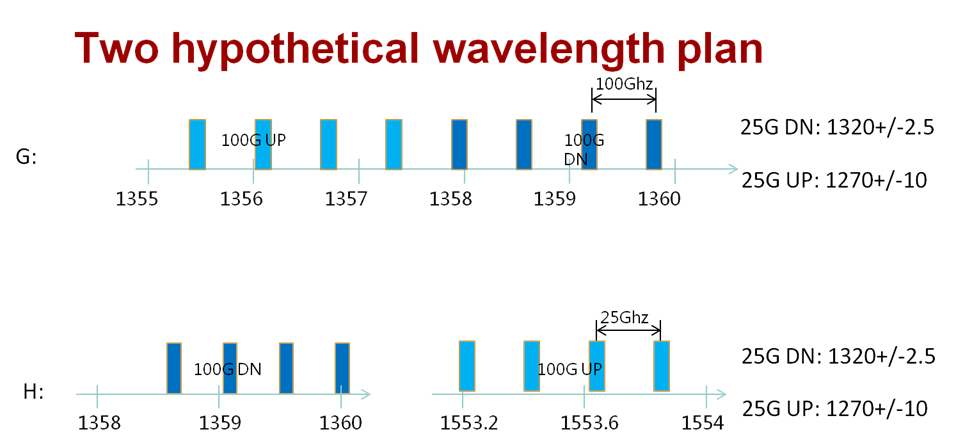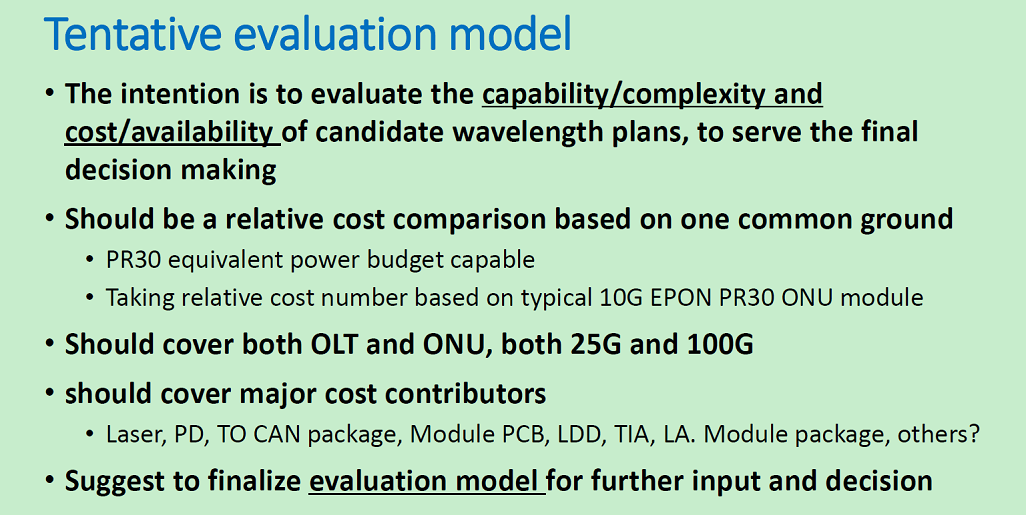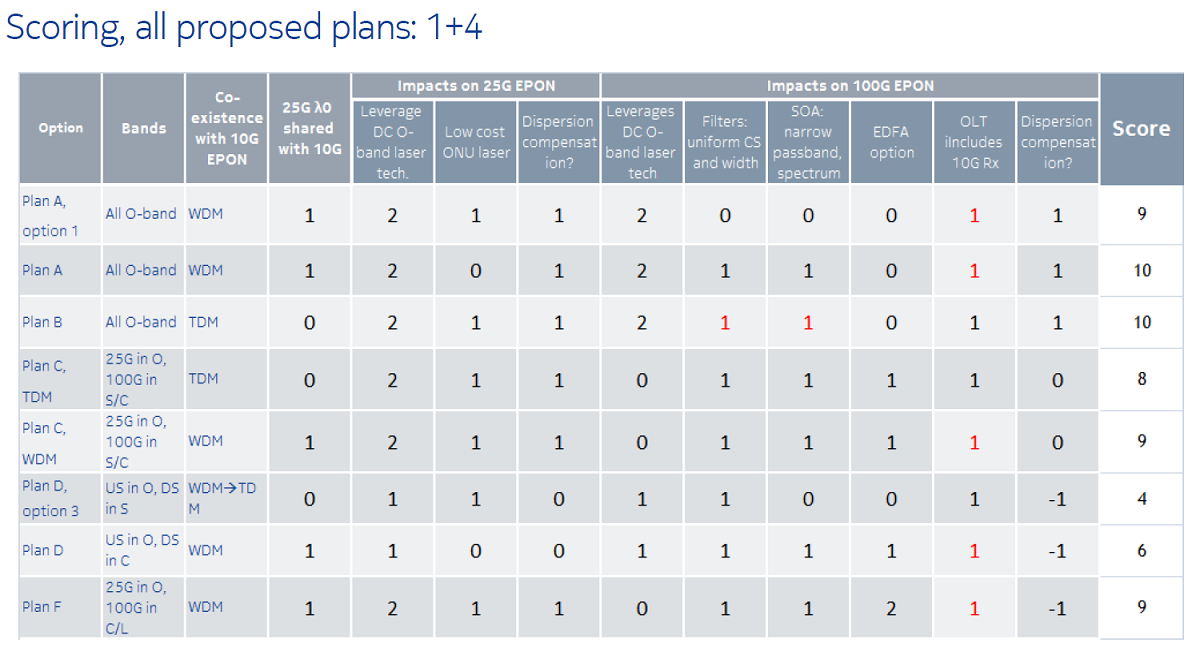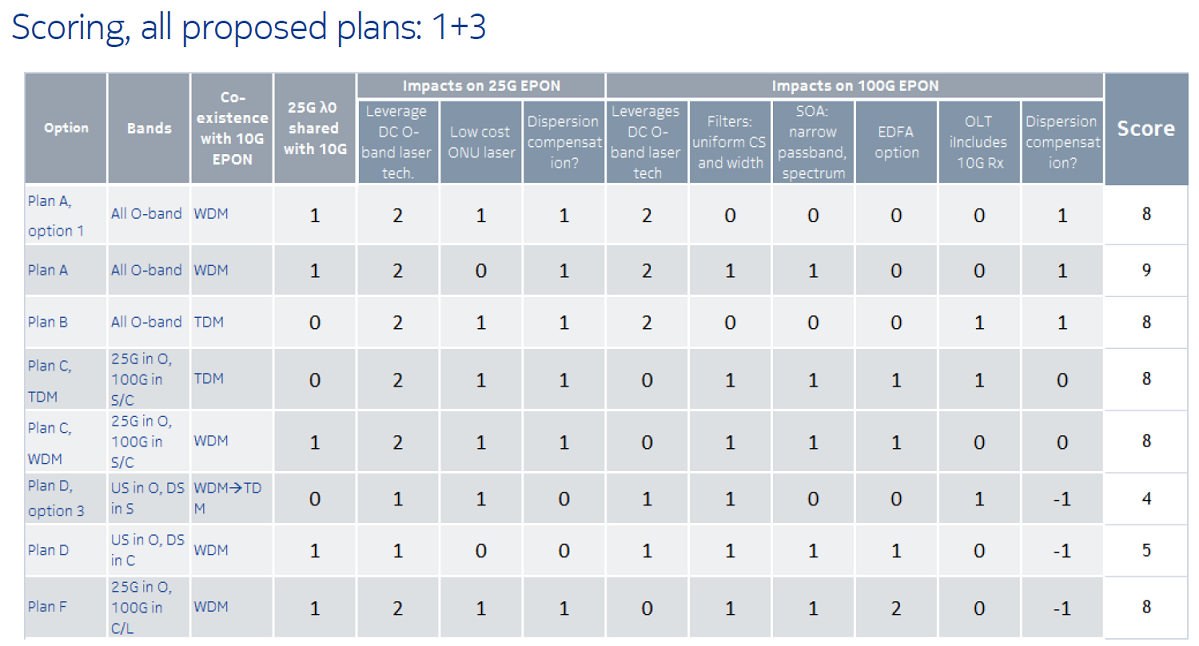Dekun,
Thanks for the detailed input.
Just to re-affirm, I only included criteria that differentiated the four remaining plans A, B, C, and D. For example, your hypothetical plans G and H have tight channel spacing. However I do not take channel spacing as a criterion since
all four plans use the same channel spacing, 800 GHz. If we decided to introduce new plans (or modify existing plans) with different channel spacings, then for sure this criterion would need to be added.
This is the reason I also did not include some of the other criteria you suggest: laser type, wavelength accuracy, launch power, receiver sensitivity etc. These are for sure critical for low cost, but I think we have already eliminated
plans that would score poorly on these criteria.
I agree with you on this point and will make the change. I was mixing together cost and risk, and you are right that they should be considered separately, along with upstream channel sharing.
l
Feasibility issue and requirement issue should be segregated
p
SOA narrow pass band spectrum or EDFA option
p
25G λ0 shared with 10G and OLT including 10G Rx
I also agree that ONU costs must be weighted much more heavily than OLT costs, and have tried to do that. If you think I have not weighted ONUs heavily enough, we can discuss and adjust the weights accordingly.
Ed
From: Liudekun [mailto:liudekun@xxxxxxxxxx]
Sent: Sunday, October 30, 2016 11:52 PM
To: Harstead, Ed (Nokia - US) <ed.harstead@xxxxxxxxx>; STDS-802-3-NGEPON@xxxxxxxxxxxxxxxxx
Subject: RE: [802.3_NGEPON] Proposed weighting of criteria for wavelength plan comparison model
Dear Ed:
Thanks for your homework on the comparison model. As discussed in previous emails, some more factors need to be taken account in for solutions comparison,
otherwise, it will result in some unreasonable conclusions (such as the hypothetical plan G and H in the attachment get the best scores ,but are the most expensive solutions ) .
Based on the discussion in previous , I add some more items in the comparison model.
We can discuss this on the incoming meeting. I send it out now ,hopefully with some pre-discussion , we can finalize the comparison model in the meeting
and choose one wavelength plan accordingly.


Best regards
Dekun Liu
____________________________________________________
Advanced Access Technologies Dept.
网络研究接入技术部
Huawei Technologies Co., Ltd.
华为技术有限公司![]()
Phone: +86 027-59267217 Email: liudekun@xxxxxxxxxx
湖北武汉市关山一路光谷软件园A7-9
邮编:430074
Huawei Technologies Co., Ltd.
A7-9 Wuhan Optical Valley Software Park,Guan Shan Road,Wuhan,Hubei, P.R.China
From: Harstead, Ed (Nokia - US) [mailto:ed.harstead@xxxxxxxxx]
Sent: Friday, October 28, 2016 2:24 AM
To: STDS-802-3-NGEPON@xxxxxxxxxxxxxxxxx
Subject: [802.3_NGEPON] Proposed weighting of criteria for wavelength plan comparison model
All,
Please see the attached document which is a proposal for improving the wavelength plan comparison model, including weighting factors for the various criteria. The weighting factors attempt to reflect
the relative impact to the cost of the overall PON system (e.g. ONU costs are weighted more heavily than OLT costs).
Of course these are still only quasi-quantitative but I think a significant improvement over the simple equal weighting in the previous version.
I am sending this now so there is a chance for people to send feedback before I use them in a contribution for next month’s meeting.
Thanks,
Ed
From: Liudekun [mailto:liudekun@xxxxxxxxxx]
Sent: Monday, October 10, 2016 4:38 AM
To: Harstead, Ed (Nokia - US) <ed.harstead@xxxxxxxxx>
Cc: STDS-802-3-NGEPON@xxxxxxxxxxxxxxxxx
Subject: RE: wavelength plan updates
Ed:
Thanks for your response.
Channel spacing, laser wavelength operating range and guard band width have important impact on the optics cost . these factors decides the laser yield
, package complexity and tolerance.
We should take these factor into the cost consideration and comparison.
And we may need to separate the OLT and ONU for comparison , due to the cost impact on ONU are much more important . Based on the experience in the
past , we always need to make the ONU really in low cost.
+/-1nm laser operating range comes from that in 100G LR4 in datacenter, but as I know the price of LR4 module is a magnitude higher than 10G PON ONU
modules(10 times more expensive).
PON modules, especially for ONU, are more cost sensitive. In the past, the operating wavelength range is 20nm or 5nm in OLT (in 1G and 10G decade).
NG-PON2 begins to suffer a lot challenging on narrow operating wavelength range (such as big problem on ONU laser wavelength drifting during the burst
transient slot)
we should try to optimize that if we have the choice, rather than set +/-1nm as the optimal one.
But anyway, I think we should continue to discuss and optimize the comparison model ,and also the optimal wavelength solution.
There are some initial suggestion on evaluation model in zhang_3ca_1_0716, some factors are also listed in other contributions.
I can do some further work on this and we can discuss on next meeting in Nov.

Best regards
Dekun Liu
____________________________________________________
Advanced Access Technologies Dept.
网络研究接入技术部
Huawei Technologies Co., Ltd.
华为技术有限公司![]()
Phone: +86 027-59267217 Email: liudekun@xxxxxxxxxx
湖北武汉市关山一路光谷软件园A7-9
邮编:430074
Huawei Technologies Co., Ltd.
A7-9 Wuhan Optical Valley Software Park,Guan Shan Road,Wuhan,Hubei, P.R.China
From: Harstead, Ed (Nokia - US) [mailto:ed.harstead@xxxxxxxxx]
Sent: Tuesday, October 04, 2016 7:16 AM
To: Liudekun; STDS-802-3-NGEPON@xxxxxxxxxxxxxxxxx
Subject: RE: wavelength plan updates
Dekun,
Thanks for your feedback!
Generally speaking, if you don’t believe the scoring is correct, then we need to focus on slide 8. The simple scoring only reflects the number of green checkmarks minus the number of red X’s on
this slide. So either we don’t have the right comparison criteria (the column headings) or they need to be weighted. I agree with you that weighting the criteria would be a useful refinement—that is listed as a potential next step in slide 17. Let’s work
together on that.
Regarding your hypothetical Plan G: I did not include 100G channel spacing as a criterion since all plans support the same 800 GHz channel spacing—there is no differentiation on this point. If Plan
G were to be considered (only 25 GHz CS), then I would add 100G channel spacing as a criterion, and it would be penalized accordingly.
Now that I have written that, I went back and looked again at Plan F more closely. I see that the upstream has 5 nm spacing but the downstream only 2 nm spacing. Therefore, you are correct that
I did not take that into account, and Plan F should be penalized for the tighter downstream channel spacing. However, Plan F did not make the “cut”.
Ed
From: Liudekun [mailto:liudekun@xxxxxxxxxx]
Sent: Thursday, September 29, 2016 4:11 AM
To: Harstead, Ed (Nokia - US); STDS-802-3-NGEPON@xxxxxxxxxxxxxxxxx
Subject: RE: wavelength plan updates
Dear Ed:
Thanks for your home work and effort on the comparison.
I am sorry that I missed the comparison discussion on the Thursday morning in last meeting, so I may miss something.
But I just found the following comparison mode can’t really reflect the advantage and disadvantage of different plans, especially for 100G EPON.
For example, Plan D , which is “putting all upstream in O band, downstream in C/S band, at least 800GHz channels spacing” gets a distinct lower score (only 6 score) than plan F (9
score), this seems mean that plan F is a much better plan than plan D.
I just can’t understand why this can happen.
Plan F is putting downstream in L band , upstream in C band, using 100GHz channel spacing (very narrow channel spacing), Such 100G system should be much more expensive than plan D,
but it just can get much higher score in the follow comparison table.
I have tried a further extreme solution, if there is a plan G: upstream and downstream are 8 consecutive 25GHz spacing wavelength in C band , such as US: 193.0, 193.025, 193.05,
193.075THz, DS: 193.1,193.125 193.15.193.175THz, both upstream and downstream channel spacing are 25GHz , DS/US gap are also 25GHz, such 100G system should be very very expensive but it still can get a much higher score than plan D based on the following
model.
So from me ,the evaluation model in the following table still needs further discussion and optimization , before we really can compare different solutions.
Here are my some comments and concerns on this model shown in the following tables:
1.
In this model, some items very important to the cost haven’t been taken account in, such as laser central wavelength accuracy requirement(+/-0.1nm or +/-1nm, or +/-10nm…) , guard band width(2nm
or 10nm …), downstream/upstream gap, different launch power levels , laser type (MZM, EML or DML), cooled or uncooled
2.
Some items are on much lower weight but have the same score/weight with other item, such as Uniform channel spacing and width(a lower case item ), the impact on the cost are much smaller than
“Low cost ONU laser”(the most important factor , from me) , while they have same weight on the overall comparison.
3.
Generally the cost of ONU are more important than OLT, but it seems that the model mainly consider the OLT(The only item related ONU is the low cost ONU laser, while only have 1 score value).
There are still some items which are not on the same level with others , such as EDFA option and “One 25G throughput shared w/10G”, I am not sure if one can cancel or compare with
the other one.
|
|


From: Harstead, Ed (Nokia - US) [mailto:ed.harstead@xxxxxxxxx]
Sent: Monday, September 26, 2016 11:40 PM
To: STDS-802-3-NGEPON@xxxxxxxxxxxxxxxxx
Subject: [802.3_NGEPON] wavelength plan updates
All,
Here are two documents that we would like to review on this week’s consensus call. They are:
·
Wavelength plan comparison update: updated version of 25G/50G/100G EPON wavelength plan comparisons (harstead_3ca_4b_0916) per discussion in Fort Worth, with the plans re-scored. Updates are summarized on slide
2.
·
802.3ca wavelength plan homework Sept 2016, which is an updated version of harstead_3ca_5_0916—motly added specific contributions that need to be resolved. This document supersedes harstead_3ca_5_0916. It can
be a living document if we add more items to it.
Bill will present as I will not be available for the call.
Ed